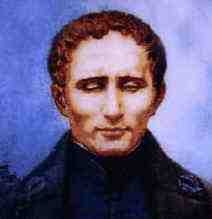Louis Braille (1809-1852) The 4th January is his anniversary of birth.

Louis Braille gave his name to the system of embossed type used across the world by blind people for reading and writing. For the first time in history, people with sight loss were able to actively engage with the world again, rather than just be passive recipients of information, dependent on others to read to them.
Braille was born to a poor family in a small town near Paris. When he was four he accidentally pierced his eye with a tool while playing in his father’s workshop. Later his other eye became infected by the first and he lost his sight altogether. Louis was sent to one of the first blind schools in the world in Paris, where the pupils were taught practical skills like chair-caning and slipper-making. Once a week, the boys were taken for a walk in the park, linked together by rope.
In 1821, a soldier named Charles Barbier visited Braille’s school. He brought a system he had invented called ‘night writing’, originally designed so soldiers could pass instructions along trenches at night in silence. It consisted of twelve raised dots that could be combined to represent different sounds, but it proved too complex to master and was rejected by the French army.
The young Louis quickly realised how useful this system could be if simplified. He experimented with different combinations until he found an ideal system using six dots. He continued to work on the scheme for several years, developing separate codes for maths and music. In 1827, the first book in braille was published. Not only could people with sight loss read braille, but they could also write it using a simple stylus to make the dots.
Louis became a teacher in the school where he had been a student but did not live to see his system widely adopted. He died from tuberculosis at the age of 43. A century after his death, his body was moved to the Pantheon in Paris, home of France’s national heroes. By then the impact of braille was global.

























